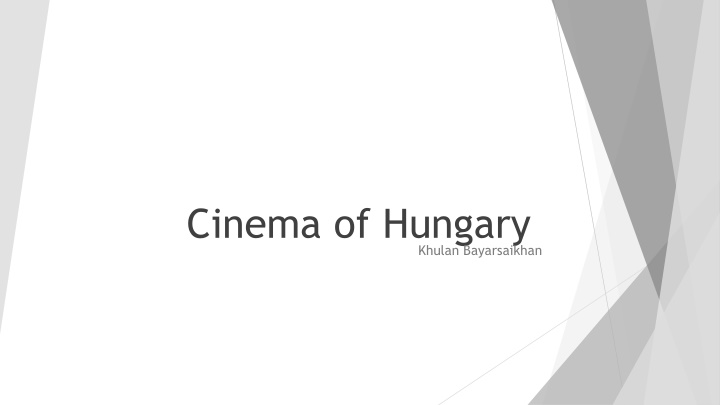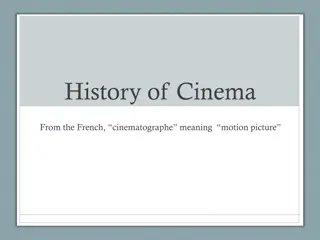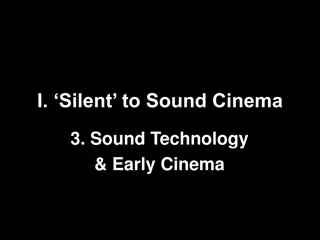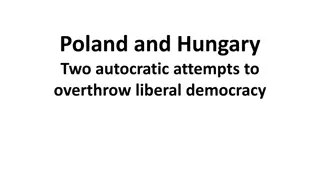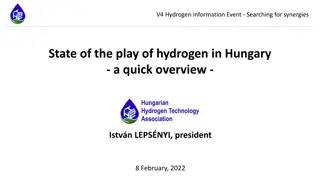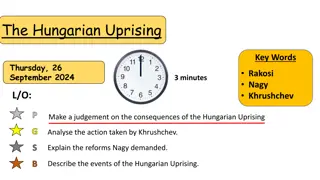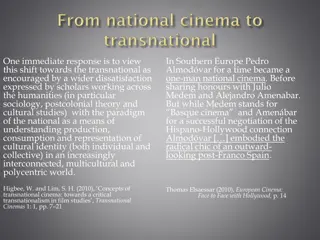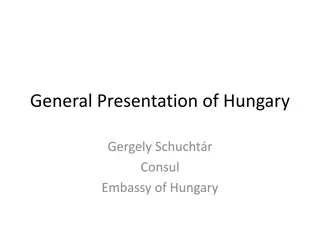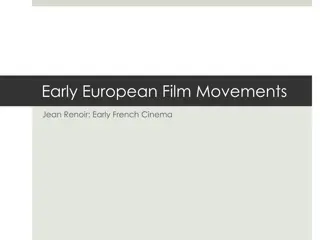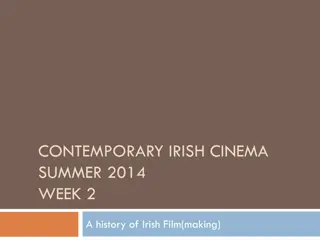Cinema of Hungary
The rich history of Hungarian cinema from its early decades in the late 19th century to the turbulent 20th century, including the impact of world events on the industry and changes in production and censorship trends. Witness the growth of theaters, the rise of iconic filmmakers like Michael Curtiz and Alexander Korda, and the flourishing of diverse genres in Hungarian films. Follow the struggles faced during wartime periods and the societal shifts reflected in movie content. Discover how Hungarian cinema adapted to challenges and innovations, shaping the country's cultural landscape.
Download Presentation

Please find below an Image/Link to download the presentation.
The content on the website is provided AS IS for your information and personal use only. It may not be sold, licensed, or shared on other websites without obtaining consent from the author.If you encounter any issues during the download, it is possible that the publisher has removed the file from their server.
You are allowed to download the files provided on this website for personal or commercial use, subject to the condition that they are used lawfully. All files are the property of their respective owners.
The content on the website is provided AS IS for your information and personal use only. It may not be sold, licensed, or shared on other websites without obtaining consent from the author.
E N D
Presentation Transcript
Cinema of Hungary Khulan Bayarsaikhan
The Early Decades(1896-1901) 1896- Lumiere brothers 10thof May The Royal Hotel of Budapest 1896- Arnold and Zsigmond Sziklai- June 41.Andrassy street-Okonograph 1911- 100 movie theatre/caf s already were operating in Budapest
The Early Decades(1986-1901) 1986- First ever film recording Lumiere brothers-march at Buda castle Zsigmond Sziklai first Hungarian cameraman 'A t nc' (The Dance)- first consciously made Hungarian film-Bela Zsitkovszky
The Early Decades(1901-1920) By 1910 270 permanent theatres operated in Hungary including Royal Apollo A characteristic style - cinema sketch hybrid of theatre and film 1919 from March to August Hungarian Soviet Republic nationalized fully
Between the Two Wars (1920-1931) After WWI Michael Curtiz, Alexander Korda career abroad like in Hollywood During twenties foreign film industry left no space French , American, Italian movies companies bankruptcy First voiced movie screening 1929 September 30 Puskin theatre The Singing Fool
Between the Two Wars ( 1931-1945) By 1932 over 500 theatres operate quarter of them in Budapest Hungarian film production boomed on 30 s rising from 6 films in 1932 to 36 films in 1927 From 1935 far-right-wing formed throughout the country protest against Jews in film industry During Horthy s government with Nazi Germany press started to put pressure to Jewish cast members In 1938 Jew Law was introduced maximal Jewish cast members 6%
50s (civil war in 1956) Several films banned many experts and actors fled the country
60s As the technology became cheap large mass of people attracted to films causing of opening small sized club and community houses to screening in Budapest hundreds of new theares opened Western modernism separation of art and entertainment films seeking for new actors and genres Disasters of 50 s replaced by action, detective and spy movies .
70s Both subjective and objective form developed through process of a stylization in 70 s documentarism and directorial films Sociological studies made the most important task real events of certain black spots in history were revealed along with the taboo subjects
80s Traditions of documentary films continued by showing problems people get rich by illegal and legal way causing others hard to find flat or job Entertainment movies was popular after collapsing of East European socialist regime in 1989
Present The transformation of filmmaking and distribution has been going on for years. Hungarian film is searching for its place, looking for new ways of expression and opportunities in changed circumstances and within new social conditions. Hungarian films are presented atfestivals abroad, get awards, and allow the world to know about the society, reality andculture of which they are a part.
Best cinema theatres in Budapest Puskin cinema Urania movie theatre Cinema city Pest Hungarian theatre Bem cinema Toldi cinema Corvin cinema
Most popular films of Hungary Mephisto (1981) Son of Saul (2015) Control (2003) The witness (1969) Satantango (1994) On body and soul(2017)
